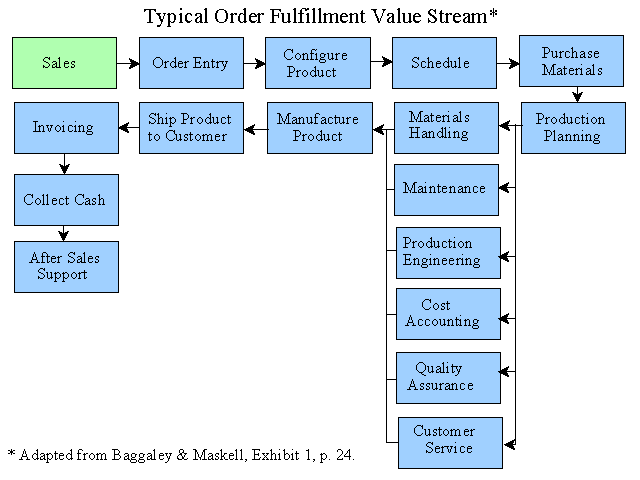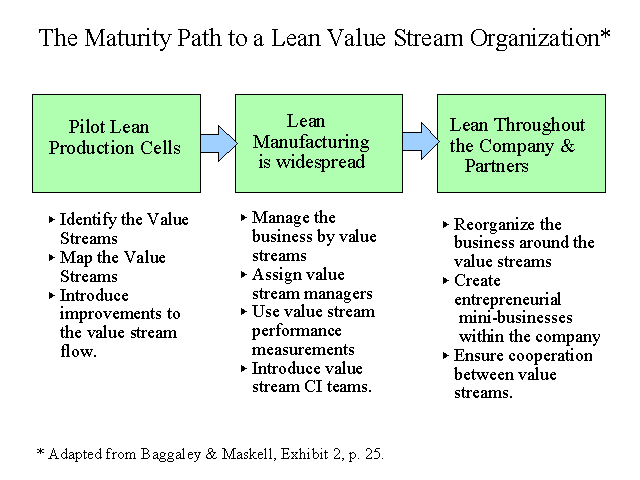
Summary by Hsin-Yi Chen
Master of Accountancy Program
University of South Florida, Fall 2004
JIT Main Page | Lean Accounting Main Page | Value
Chain Main Page
The main purpose of this article is to explain the systems and controls that are best suited to the lean company. According to the authors, there are three major lean management issues that need to be considered:
1. Developing an appropriate management focus,
2. Organizing by value stream, and
3. Costing by value stream.
This article (Part I) covers only the first two issues concerning the steps related to organizing the enterprise by value stream.
Developing an Appropriate Management Focus
A lean company places emphasis on creating value for customers. Value is added through many different processes rather than by one specific process such as production. For example, in the case where a customer places an order, value is added from taking the order, manufacturing products, shipping goods, collecting payment and after-sales services. The chain of these processes would become a value stream for sales (See Exhibit 1). A lean company recognizes the connections along the entire stream of the work performed in order to achieve a smooth flow of the product to satisfy customers; in other words, to create value for its customers.

This is the key difference between the management focus of the lean company and the traditional company. The traditional management concept focuses on organizing or managing the company by production departments. Thus, in a traditional organization structure each department is designed to be efficient rather than to produce a smooth flow of work to serve the next process or department. According to the authors, the primary purpose of management in a lean company is to identify the value stream in order to improve the flow of work required to meet customer needs, i.e., a demand pull flow rather than push.
Organizing by Value Stream
When lean manufacturing matures within the company, there is a need to manage the value stream. Thus a manager would be assigned with the profit and lost responsibility related to the value stream. The growth and improvement strategies revolve around the value stream because it provides the visibility for managing continuous improvement.
The Simplicity of Value Stream Organization
The lean company strives for simplicity of operation. Thus within a lean organization there would be only three or four value streams with a clear cut line of responsibility. A traditional organization would have a complex organization chart, hundreds of cost centers and thousands of transactions to keep track of people. It is obvious that managing with the value stream perspective really simplifies management.
Value Stream as the Focus forImprovement
For each value stream there would be a continuous improvement (CI) team to review the value stream performance measurements and make improvements on time. The CI team within the value stream can see the entire flow of the work, thus the improvement benefits the whole system rather than a single process.
Implementing the Value Stream Organization
Implementing lean manufacturing can include implementing value stream management at the same time. Basically, there are three stages in the progression (see Exhibit 2).

At stage 1, lean manufacturing is first introduced and a pilot lean cell is implemented. There is no need to change the original organization chart in the short term.
At stage 2, lean manufacturing widely spreads in the plant and product groups, crossing organizational lines within the plant as each lean cell is linked into the value streams. At this stage it is necessary to manage by value stream and assign both production and support people to each value stream. Support people are important to the value stream because they make sure that the services are there to maintain the rate of production. The authors provide an example of support functions that need to be more available to a lean value stream:
1. Production Control – to manage the size and number of
kanbans required to achieve value stream target rates of production.
2. Transportation – to ensure that the right materials and tooling are at the right cells and at the right time.
3. Procurement – to ensure that materials are received from suppliers in the right quantities and on time.
4. Manufacturing Engineering – to ensure the focus on continuous improvement.
5. Maintenance – to limit equipment downtime, especially in a constraint resource.
There may be a problem of assigning people to value streams due to a shortage of people. It may be necessary to have a person serving in many value streams for the short-term, but for the long-term cross training would become necessary to solve this problem.
It might appear that implementing lean manufacturing with the value stream concept would require additional people, e.g., several production planners rather than a single production planner. However, this potential problem can be solved in two ways by:
1. Eliminating unnecessary administrative tasks, for example, production planning would not be needed when an effective pull system is in
place.
2. Cross training can help in providing support skills in every value stream. Thus, no additional people would
be needed and each value stream would have all the required skills.
For complex organizations, they may find that a matrix management structure (people still report to their functional bosses, but are assigned to work in particular value stream teams) is a convenient way to adopt lean manufacturing without disrupting the organization. A medium or small size business can simply forego its original structure and adopt a new one to reflect value stream management.
Conclusion
The authors provide some rules of thumb as guidelines:
1. When implementing lean manufacturing and value streams, move ahead step-by-step.
2. A value stream should contain between 25 and 100 people.
When the stream contains too many people, it will not be able to maintain
the small-team focus required. When there
are too few people, it will not be able to maintain an effective operation.
3. A value stream should represent a significant part of the business.
A business usually has three major value streams and a fourth one to
combine all the other functions that do not fit in.
4. A key idea of value stream management is to have the majority of people working in
the major streams, with only a few additional supporting departments to maintain
the smooth operation of the business.
__________________________________________
Note: The second article in this set is Baggaley, B. and B. Maskell. 2003. Value stream management for lean companies, Part II. Journal of Cost Management (May/June): 24-30. (Summary).
Other related summaries:
Borthick, A. F., P. L. Bowen, and M. C. Sullivan. 1998. Controlling JIT II: Making the system monitor itself. Journal of Cost Management (July/August): 33-41. (Summary).
Carr, L. P. and C. D. Ittner. 1992. Measuring the cost of ownership. Journal of Cost Management (Fall): 42-51. (Summary).
Carr, L. P., W. C. Lawler and J. K. Shank. 2002. Reconfiguring the value chain: Levi's personal pair. Journal of Cost Management (November/December): 9-17. (Summary).
Castellano, J. F. and R. Burrows. 2011. Relevance lost: The practice/classroom gap. Management Accounting Quarterly (Winter): 41-48. (Summary).
Clinton, B. D., and H. Ko-Cheng. 1997. JIT and the balanced scorecard: Linking manufacturing control to management control. Management Accounting (September): 18-24. (Summary).
Crusoe, J., G. Schmelzle, and T. E. Buttross. 1999. The hidden costs of adopting JIT manufacturing. Journal of Cost Management (December): 23-26. (Summary).
Davenport, T. H. and J. Glaser. 2002. Just-in-time delivery comes to knowledge management. Harvard Business Review (July): 107-111. (Summary).
Deluzio, M. C. 1993. Management accounting in a just-in-time environment. Journal of Cost Management (Winter): 6-15. (Summary).
Deluzio, M. C. 1993. The tools of just-in-time. Journal of Cost Management (Summer): 13-20. (Summary).
Foster, G. and C. T. Horngren. 1987. Cost accounting and cost management in a JIT environment. Management Accounting (June): 19-25. (Summary).
Fullerton, R. R. 2003. Performance measurement and reward systems in JIT and non-JIT firms. Cost Management (November/December): 40-47. (Summary).
Fullerton, R. R. and C. S. McWatters. 2002. The role of performance measures and incentive systems in relation to the degree of JIT implementation. Accounting, Organizations and Society 27(8): 711-735. (Summary).
Goodson, R. E. 2002. Read a plant - fast. Harvard Business Review (May): 105-113. (How the rapid plant assessment (RPA) process can tell you if a factory is truly lean in as little as 30 minutes. The process includes two tools: The RPA rating sheet includes 11 categories for assessing leanness, and the RPA questionnaire includes 20 yes or no questions). (Summary).
Kalagnanam, S. S. and R. M. Lindsay. 1998. The use of organic models of control in JIT firms: Generalising Woodward's findings to modern manufacturing practices. Accounting, Organizations and Society 24(1): 1-30. (Summary).
Kapanowski, G. 2016. Lean fundamentals for accountants. Cost Management (January/February): 5-14. (Summary).
Kapanowski, G. 2017. Lean accounting. Cost Management (January/February): 37-41. (Summary).
Lee, J. Y. and J. K. Winch. 1998. From push to pull: Management's control system modification for manufacturing change. Advances in Management Accounting (6): 75-92. (Summary).
Lessner, J. 1989. Performance measurement in a just-in-time environment: Can traditional performance measurements still be used? Journal of Cost Management (Fall): 23-28. (Summary).
Maginnis, M. A. and G. Uminger. 2018. Management accounting in a true lean (TPS) environment. Cost Management (January/February): 27-35. (Summary).
Martin, J. R. Not dated. Chapter 8: Just-In-Time, Theory of Constraints, and Activity Based Management Concepts and Techniques. Management Accounting: Concepts, Techniques & Controversial Issues. Management And Accounting Web. Chapter8.htm
Martin, J. R. Not dated. Lean concepts and terms. Management And Accounting Web. Lean Concepts and Terms Summary
Martin, J. R. Not dated. Profit Beyond Measure graphics and notes. Management And Accounting Web. Johnson Broms Graphics Notes
Martin, J. R. Not dated. What is lean accounting? Management And Accounting Web. LeanAccounting.htm
McIlhattan, R. D. 1987. How cost management systems can support the JIT philosophy. Management Accounting (September): 20-26. (Summary).
O'Brien, J. and K. Sivaramakrishnan. 1994. Accounting for JIT: A cycle time-based approach. Journal of Cost Management (Fall): 63-70. (Summary).
Patell, J. M. 1987. Adapting a Cost accounting system to just-in-time manufacturing: The Hewlett-Packard Personal Office Computer Division. Accounting & Management Field Study Perspectives, edited by William J. Bruns, Jr. and R. S. Kaplan. Harvard Business School Press: 229-267. (Summary).
Pickering, M. 2017. Implementing lean management reporting in lean enterprises. Cost Management (January/February): 28-36. (Summary).
Swenson, D. W. and J. Cassidy. 1993. The effect of JIT on management accounting. Journal of Cost Management (Spring): 39-47. (Summary).
Toyota Public Affairs Division and Operations Management Consulting Division. 1998. The Toyota Production System: Leaner Manufacturing for a Greener Planet. The Toyota Motor Corporation. (Summary).
Vollmann, T. 1990. Changing manufacturing performance measurements. Proceedings of the Third Annual Management Accounting Symposium. Sarasota: American Accounting Association: 53-62. (Summary).